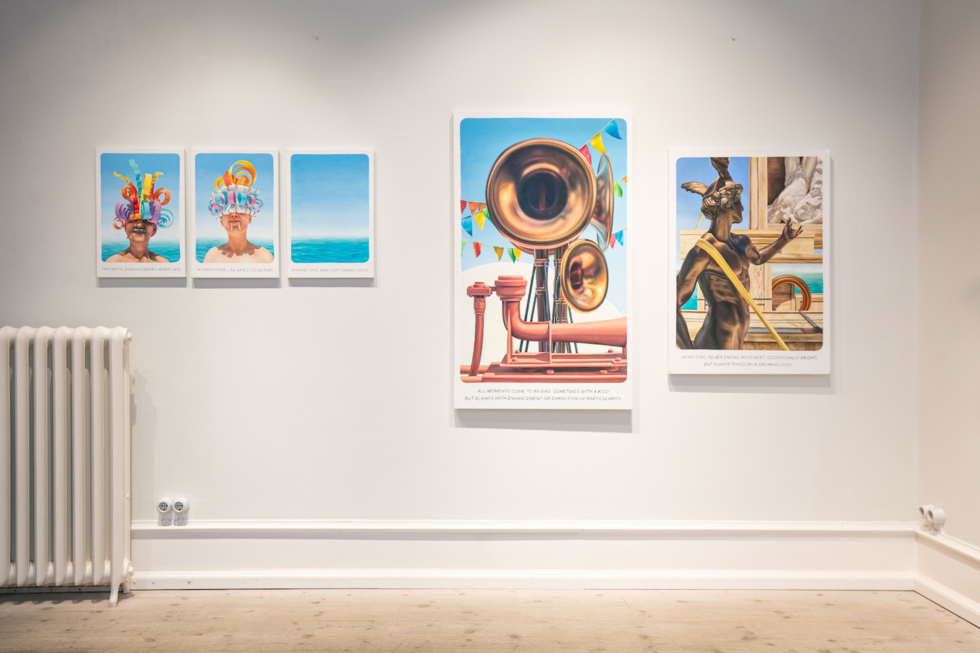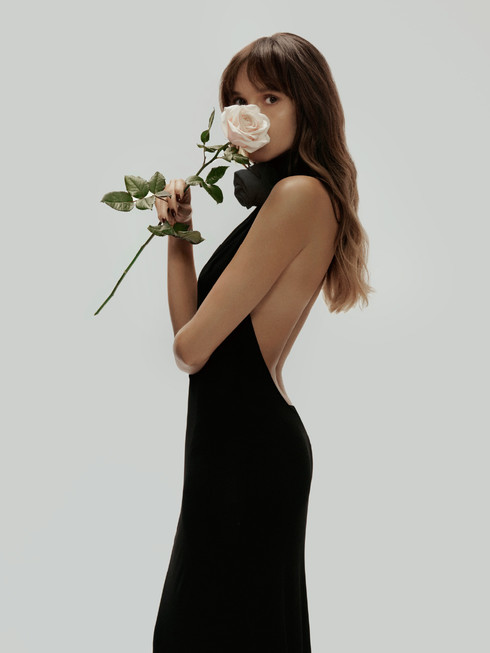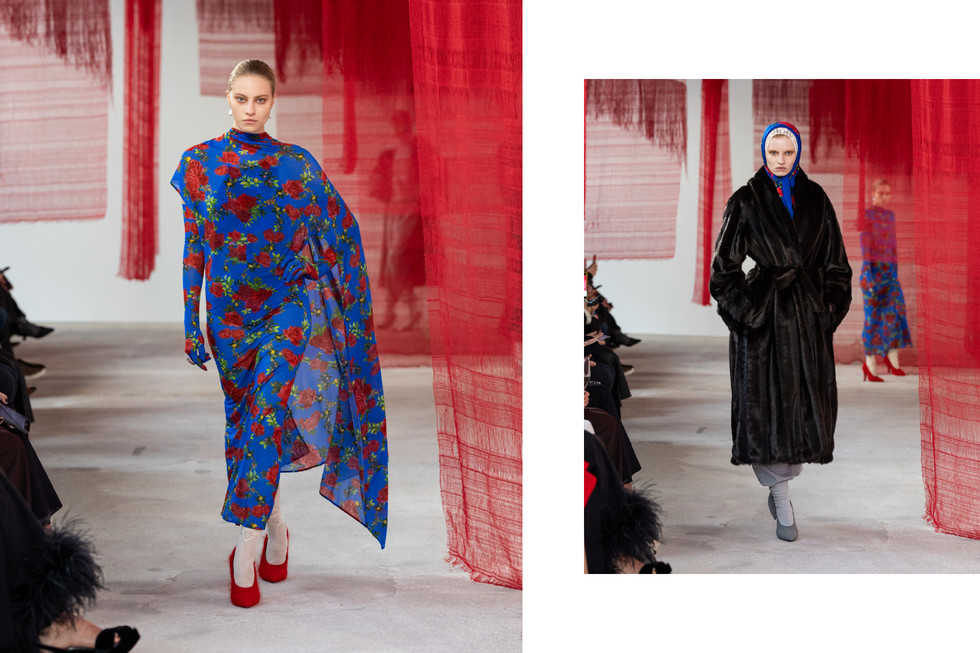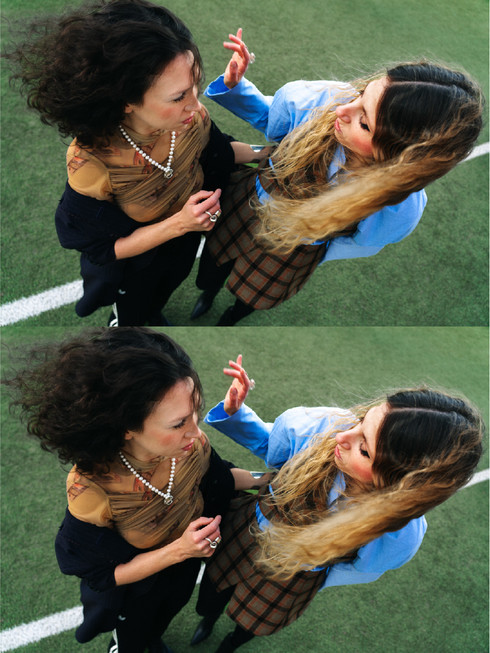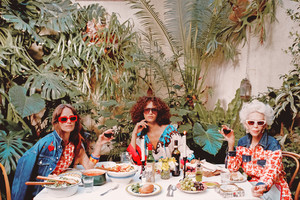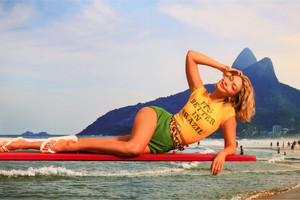“The Erosion of Reason”: Gustaf Lilliestierna on Blurring Reality and Imagination
Written by Natalia MunteanIn his latest exhibition at WAY Gallery in Stockholm, titled The Erosion of Reason, Gustaf Lilliestierna invites viewers into a world where reality and imagination blur, creating a “parallel sense of time” that feels both familiar and foreign. His paintings, which he describes as “hyper images,” are more than just visual representations, they are layered with fragments of memory, ideas, and visual impulses that challenge our understanding of what is real. “I enjoy the childish qualities,” he admits, reflecting on the playful yet profound nature of his work. “I want it to be as enjoyable for a six-year-old as it is for a sixty-year-old theorist.”
Gustaf’s process is deeply intuitive, often starting with a single image or idea that leads to another. “One thing just leads to another,” he explains. “I might have 50 ideas, and then I’m trying to understand how these ideas relate to each other. How can they be combined?” For Gustaf, the act of painting is as much about discovery as it is about creation. “They are always a mystery,” he says of his works. “I do wish to see them, so I make them. But in the end, they become material for new thoughts.” Through evocative painting and a deep engagement with nostalgia and inspiration, Gustaf’s art invites viewers to explore the spaces where reality and imagination intersect
Natalia Muntean: How did you develop the concept of “hyperimages,” and what is the most challenging part of creating them?
Gustaf Lilliestierna: “Hyperimagery” started as a term I used once, and I noticed how helpful it was. Without it, I could describe my practice as a problematisation of referencelessness, or perhaps referential ambiguity, in visual representation. Or, I could say it’s a playful attempt to provoke new mental images through depiction. But neither explanation fully captures my practice, and they’re unfair to the immediate experience of my pieces. I often spiral when asked, “What do you do?” So, I embraced the term “hyperimagery,” which popped into my head, and it’s been useful ever since. When I use it, I’m referring to images that are intuitively, and perhaps even ontologically, perceived as more than one image.
NM: How do you define the relationship between reality and imagination in your work?
GL: This question is larger than life! Every attempt to define this relationship pushes the line that represents the “between.” If we assume reality is everything that exists independently of our thoughts, then no such line can exist without us imagining it. A perspective from that line—bordering reality on one side and imagination on the other—would inevitably come from a position within the “non-real.” Any answer inspired by this juxtaposition will be unsatisfactory. We must consider whether we’re answering from individual, separate realities and imaginations, positioned behind a line we can’t fully access. If so, it’s hard to say anything definitive about “the” or “a” reality. If we still believe we can describe “the” reality we all share without including imagination, our book of knowledge would be very thin. Perhaps I’m too cautious to answer this question. But I can say this: I love being a mind. And as a mind, I find myself superpositioned between these fields, though I try to avoid the border between them.
NM: Do you think your paintings reveal more about the viewer’s mind or your own as the creator?
GL: I believe that artistic experiences truly smite us, and while being affected by something like art, something stirs within. But I would not say that art can reveal anything in particular. That would be a trait much too specific to bestow upon something as vague and elusive as a piece of art; considering all the various interpretations of expressive values not to say our unmatched responses to the gestures of artistic expression. I would rather describe this state of mind as the arousal of admittance before something we do not know. Nonetheless, this presence makes itself known by manifesting an unknown. And we are responsible, as individuals, for discovering what heals this sudden void. In my opinion, art is at its best when it becomes a condition in which conscious events take place. The end of this event might reveal something to ourselves, but I believe that the power of art is the power to initiate this process, not to guide us through it.
NM: Why do nostalgia and melancholy play such a central role in your work?
GL: As a nostalgic and artistic person, I argue that the nostalgic experience resembles the artistic - but on an emotional level. If we assume that art is an event, as described above, then it is not hard to see that nostalgia uses the same toolbox while managing our mood. Like art, nostalgia is characterised by internal conflict. But rather than a conflict of concepts, ideas and expressions, nostalgia is a conflict between contingent experience, time, and failed expectations. It is unfair to compare nostalgia to longing since it often appears out of the blue. It usually, just like art, smites us. It is therefore easy to ‘mistake’ nostalgic experiences for artistic experiences, and to me, nostalgia is the closest one might come to art without being subjected to what we normally call an ‘artwork’. But unlike feelings such as happiness or sadness, nostalgia is hard to represent with an emoji. Melancholy to me is the nostalgia we feel before our loss. In my experience, both nostalgia and melancholy are natural consequences of being a mind subjected to change - so if one agrees that art can change you, then feelings of nostalgia might emerge without any particular or known reason. Sometimes it can even be an indicator.
NM: Where do you find inspiration for the fragments of memory, ideas, and visual impulses that make up your hyperimages?
GL: It’s hard to pinpoint, but a vague answer would be other hyperimages. I think of them as examples of excessive visualisation. A specific hyperimage might end up in my mental image bank and later become part of “unproductive” thinking. One thing leads to another, and suddenly you have a theme. I tend to obsess over certain “mind-places” and sometimes never really leave them. I’ve been on a fictional island for almost two years now, the drama there isn’t fully resolved, but I feel I’ll be ready to leave soon. A new place or situation must occupy my focus, and that can happen anywhere, anytime. When it does, I can’t dismiss its effect. A month from now, I might witness something extraordinary from a bus window, something that really draws me in. My work involves refining and mimicking this extravagance. A few years ago, I experienced something I hadn’t yet processed: an autumn market on my street. They’d advertised it for weeks, but when the day came, it poured rain. Everyone stood there, soaked, with no customers. At the end of the day, an older man, maybe in his seventies, gave up. He was selling helium balloons shaped like animals and cartoon characters. He had the saddest expression as he tried to fit all the unsold balloons into his car.
NM: Do you start with a specific concept or emotion, or do the ideas emerge as you paint?
GL: I will answer this very briefly, but the answer is very effective: when one thinks of an image like ‘the man and the balloons,’ one thing just leads to another.
NM: What techniques or materials do you use to create the dreamlike, almost surreal quality in your paintings?
GL: I'm flattered that you point out these qualities in my work! The dreamlike-ness often emerges from the lack of physical references. My method involves a lot of guessing, a lot of frustrating problem-solving, a lot of logic, and of course some intuition and impulse. Despite the ambition to make it look ‘realistic’, it is very important for me that it resembles something that derives from thought. I suspect that it is easier for a painting to transform into thought in that way, and that is definitely a goal.
NM: How do you decide on the colour palette and composition for a piece?
GL: I always start by drawing. Sometimes the final product of this ‘thinking by doing’ activity consists of several, usually 5-10, drawings. Sometimes it results in depictions of buildings, people, streets, objects, or just faces. This collection gives me an idea (if I'm not currently under the influence of one). The idea however is never better than the composition and is only worth realising if I'm pleased with the aesthetic quality of the visuality in a given form. I therefore make a lot of lines and measurements within a drawn dimensional frame. It is perhaps a golden ratio fetish, but I need it for motivation. When the proportions of my ‘abstract composition’ correspond with my collection of imagery nicely, I further compose the image using the chosen means. I then translate the drawing into an oil painting. I try to keep it as mind-dependent as I possibly can, but sometimes I do real-life drawing, and build models or digital illustrations as support. The colour palette depends on the mood, which is revealed by the scene. It always ends up in a certain place, at a certain hour.
NM: How do you know when a painting is finished, especially when dealing with such abstract and elusive concepts?
GL: It’s a question of just stopping. In one way, they’re never thematically finished. I finish the drawing when it’s close to what I had in mind, and I finish the painting when it looks cool and convincing. Sometimes I manipulate the idea, maybe adding a road sign, a lamp, or another figure. But this is risky, and when it happens, I often start over. I do a lot of work outside the studio: thinking, drawing, reading, exploring, and writing. I usually trust the process once I pick up the brush. I also evaluate my process between paintings, being careful about the direction a series is headed.
NM: What does the title The Erosion of Reason mean to you, and how does it reflect the themes of the exhibition?
GL: I wanted a title that reflected my previous claims about the immediacy of artistic experience. I wanted to align this with the view that every artwork represents a possible antithesis to a possible linguistic conclusion. I decided that “The Erosion of Reason” was a good fit, since it packs several punches: “The Erosion of Motive”, “The Erosion of Cause”, and “The Erosion of Rational Thinking”. In the case of art, something like an erosion of reason (as the erosion of motive, cause, and rational thinking) becomes beneficial if we wish to see, experience and feel without limitation. In such cases, the erosion of reason occurs simultaneously with the accretion of understanding! This became a notion that really attracted me, and it seemed almost obvious to use it as a title when I first wrote it down.
NM: How do you hope viewers will feel or think after experiencing the exhibition?
GL: This might sound a bit dorky and pretentious, but it would be amazing if the exhibition had the same effect on the viewer as a starry sky has on a curious kid. I would be pleased however, if it only managed to conjure an aesthetic interest, and it would make me really happy if it encouraged viewers to openly seek out and enjoy the influence of art more often than they already do. Nonetheless, the overall goal is that when a couple of friends go for a beer after visiting the show, they will utter things like “This was fun” or “Let's do it again sometime soon!”.
NM: Do you create your work with a specific audience in mind, or do you leave it open to interpretation?
GL: Sometimes, I do imagine myself as a five-year-old kid playing chess with my grandfather who died later that year. I use the word playing here to describe a game of play-pretend because we were not actually playing chess. He was born in the 20´s and I was born in the 90's. He enjoyed art, literature and culture and as any child, I enjoyed all sorts of creative make-believe. Unfortunately, I did not get to know him in person, but according to my dad, he was a bit of a snob when it came to the subjects of his interest. The specific audience I have in mind would probably include anyone who falls somewhere on the spectrum between this child and this old man. The curious, superficial and creative - and the ageing, theoretical and realistic. I thrive when my work appears to entertain them both. So my specific audience includes all estates of the realm sort of saying, which somewhat dilutes the specificity of the audience as one kind.
NM: Do you see your paintings as individual stories, or do they form a larger narrative when viewed together in the exhibition?
GL: My ambition with “The Erosion of Reason” was to create a narrative conveyed through a whisper that exists between multiple paintings. It is the viewer's responsibility to “listen” and interpret the story. In this sense, it represents a larger narrative! However, this story is meant to be explored rather than simply told. It is important to view each piece as an individual artwork, as our understanding of their unique characteristics influences how we respond to this whisper.
NM: Which artists, movements, or personal experiences have influenced your creative process the most?
GL: I enjoy works that communicate an eerie stillness that somehow evokes pleasurable emotion connected to safety; regardless of all the oddities and absurdities the work might express. I am heavily influenced by painters like Giorgi De Chirico, David Hockney, and Neo Rauch, among others. When it comes to movements I appreciate pittura metafisica, realism, romanticism, precisionism and some surrealism. I’m also inspired by poetry. Especially the poetry of Jack Spicer, Rosemary Waldrop and Denise Levertov. When it comes to theory I enjoy deflationism, object-oriented ontology and phenomenology - the latter a bit more than I would like to confess. Graham Harman, Jennifer Robinson and Kendall Walton are a few names worth mentioning here. I'm also inspired by harbours, tourism, passing time, peripheral life, death, poverty and almost every kind of bar.
NM: Do you think art has the power to change how people perceive reality?
GL: Absolutely. Most definitely.
NM: Are there any new themes, techniques, or ideas you’re excited to explore in your future work?
GL: Yes. I'm working on a few monochrome paintings right now. I’m not exactly sure where they will end up - but it seems to be circling around some celestial phenomena in the middle of the night. This series is currently at a very early stage, but I can confess that I'm thinking a lot about light. But the light that comes from an imaginary sun, the “phantasiphos”, is the imaginary light.



